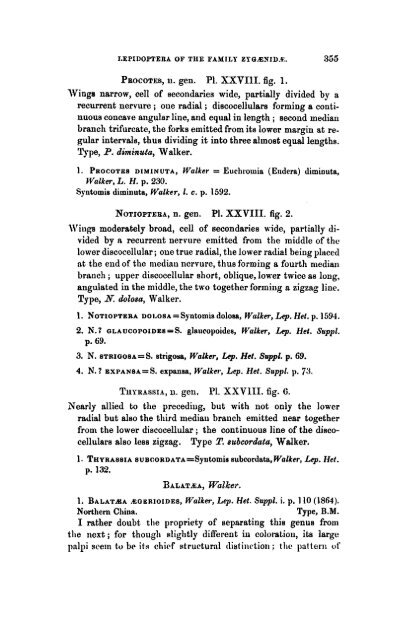Notes on the Lepidoptera of the Family Zygnid, with ... - Wallace Online
Notes on the Lepidoptera of the Family Zygnid, with ... - Wallace Online
Notes on the Lepidoptera of the Family Zygnid, with ... - Wallace Online
You also want an ePaper? Increase the reach of your titles
YUMPU automatically turns print PDFs into web optimized ePapers that Google loves.
LEPIDOPTEBA OF THE FAMILY ZTOA3NII)N.. 365<br />
PBOCOTES, n. gen. P1. XXVIII. fig. 1.<br />
TVinga narrow, cell <strong>of</strong> sec<strong>on</strong>daries wide, partially divided by a<br />
recurrent nervure ; <strong>on</strong>e radial ; discocellulars forming a c<strong>on</strong>tinuous<br />
c<strong>on</strong>cave angular line, and equal in length ; sec<strong>on</strong>d median<br />
branch trifurcate, <strong>the</strong> forks emitted from its lower margin at regular<br />
intervals, thus dividing it into three almost equal lengths.<br />
Type, P. diminuta, Walker.<br />
1. PROCOTES DIMINUTA, Walker = Euchromia (Endera) diminuta,<br />
Walker, L. H. p. 230.<br />
Syntomis diminuta, Walker, 1. c. p. 1592.<br />
NOTIOPTEBA, n. gen. P1. XXVIII. fig. 2.<br />
Wiiigs moderately broad, cell <strong>of</strong> sec<strong>on</strong>daries wide, part,ially divided<br />
by R recurrent nervure emitted from <strong>the</strong> middle <strong>of</strong> <strong>the</strong><br />
lower discocellular; <strong>on</strong>e true radial, <strong>the</strong> lower radial being placed<br />
at <strong>the</strong> end <strong>of</strong> <strong>the</strong> median ncrvure, thus forming a fourth median<br />
branch ; upper discocellular short, oblique, l<strong>on</strong>er twice as l<strong>on</strong>g,<br />
angulated in <strong>the</strong> middle, <strong>the</strong> two toge<strong>the</strong>r forming a zigzag line.<br />
Type, N. dolosa, Walker.<br />
1. NOTIOPTERA Doi.osa=Syntomis doloes, Walker, Lep. Het. p. 1591.<br />
2. N.? GLAUCOPOIDES=S. glaucopoides, Walker, I+. Het. Suppl.<br />
p. 69.<br />
3. N. STRIGOSA=S. strigom, Walker, Lep. Het. Suppl. p. 69.<br />
4. N.? BXPANSA=S. expansa, Walker, Lep. Het. Suppl. p. 73,<br />
THTRASSIA, 11. gen. P1. XXVIII. fig. 6.<br />
Nearly allied to <strong>the</strong> preceding, but <strong>with</strong> not <strong>on</strong>ly <strong>the</strong> lower<br />
radial but also <strong>the</strong> third median branch emitted near toge<strong>the</strong>r<br />
from <strong>the</strong> lower discocellular ; <strong>the</strong> c<strong>on</strong>tinuous line <strong>of</strong> <strong>the</strong> discocellulars<br />
also less zigzag. Type I! eubcordata, Walker.<br />
1. THYRASSIA SUBCORDATA=SptOmil3 subcordata, Walker, Lep. Het.<br />
p. 132.<br />
BALATIEA, Walker.<br />
1. BALATAIA<br />
boERIoIDEs, Walker, Lep. Het. suppl. i. p. 110 (1861).<br />
Nor<strong>the</strong>rn China. Type, B.M.<br />
I ra<strong>the</strong>r doubt <strong>the</strong> propriety <strong>of</strong> separating this genus from<br />
<strong>the</strong> next ; for though slightly different in colorati<strong>on</strong>, its large<br />
palpi seein to be its chief structural distincti<strong>on</strong> ; <strong>the</strong> patterii <strong>of</strong>












